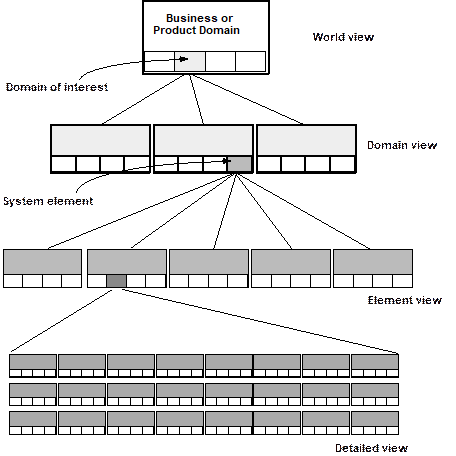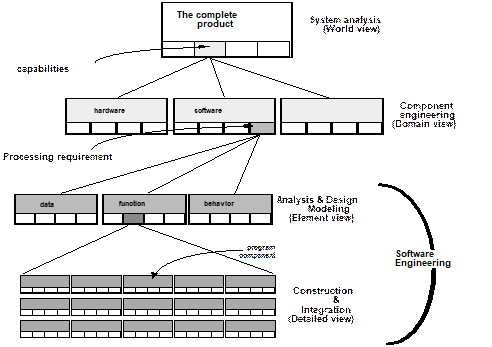Chapter 6
System Engineering
CHAPTER OVERVIEW AND COMMENTS
This intent of this chapter is to provide a brief introduction to the system engineering process. The overall structure of computer-based systems is discussed and a brief overview of the system engineering hierarchy is presented. Business process engineering (BPR) and product engineering are discussed in overview fashion.
Note: Some reviewers of this edition argued that a discussion of system engineering is beyond the scope of a software engineering text.
S/W Eng occurs as a consequence of a process called System engineering. System Engineering focuses on analyzing, designing, and organizing those elements into a system that can be a product, a service, or a technology for the transformation of information.
6.1 Computer-Based Systems
This section introduces the systems view of engineering (all complex systems can be viewed as being composed of cooperating subsystems). The elements of computer-based systems are defined as software, hardware, people, database, documentation, and procedures.
A computer-based system makes use of a variety of system elements.
Software: programs, data structures, and related work products.
Hardware: electronic devices that provide computing capabilities.
People: Users and operators of hardware and software.
Database: A large, organized collection of information that is accessed via S/w and persists over time.
Documentation: manuals, on-line help files.
Procedures: the steps that define the specific use of each system element.
One complicating characteristic of computer-based system is that the elements constituting one system may also represent one macro element of a still large system.
The micro-element is a computer-based system that is one part of a larger computer based system.
6.2 The System Engineering Hierarchy
The key to system engineering is a clear understanding of context. For software development this means creating a "world view" and progressively narrowing its focus until all technical detail is known.
In software engineering there is rarely one right way of doing something. Instead designers must consider the tradeoffs present in the feasible solutions and select one that seems advantageous for the current problem. This section lists several factors that need to be examined by software engineers when evaluating alternative solutions (assumptions, simplifications, limitations, constraints, and preferences).
Regardless of its domain of focus, system eng. Encompasses a collection of top-down and bottom-up methods to navigate the hierarchy illustrated below:

The system eng. Process usually begins with a “world view.” The entire business or product domain is examined to ensure that the proper business or technology context can be established.
The world view is refined to focus more fully on a specific domain of interest.
Within a specific domain, the need for targeted system elements (data, S/W, H/W, and people) is analyzed.
Finally, the analysis, design, and construction of a targeted system element are initiated.
6.2.1 System Modeling
System modeling is an important element of the system eng. Process. The Engineer creates models that:
To construct a system model, the engineers should consider a number of restraining factors: “Read examples of each in book page# 127.”
6.3 Business Process Engineering: An Overview
The goal of Business Process Engineering (BPE) is to define architectures that will enable a business to use information effectively.
BPE is one process for creating an overall plan for implementing the computing architecture.
Three different architectures must be analyzed and designed within the context of business objectives and goals:
The data architecture provides a framework for the information needs of a business. The building blocks of the architecture are the data objects that are used by the business.
Once a set of data objects is defined, their relationships are identified. A relationship indicates how objects are connected to one another.
The application architecture encompasses those elements of a system that transform objects within the data architecture for some business purpose.
The technology infrastructure provides the foundation for the data and application architectures. The infrastructure encompasses the h/w and s/w that are used to support the applications and data.

6.4 Product Engineering: An Overview
Emphasize that software engineers participate in all levels of the product engineering process that begins with requirements engineering. The analysis step maps requirements into representations of data, function, and behavior. The design step maps the analysis model into data, architectural, interface, and software component designs.
6.5 System Modeling with UML
Source: https://www2.southeastern.edu/Academics/Faculty/galkadi/285/notes/Chapter6.doc
Web site to visit: https://www2.southeastern.edu
Author of the text: indicated on the source document of the above text
If you are the author of the text above and you not agree to share your knowledge for teaching, research, scholarship (for fair use as indicated in the United States copyrigh low) please send us an e-mail and we will remove your text quickly. Fair use is a limitation and exception to the exclusive right granted by copyright law to the author of a creative work. In United States copyright law, fair use is a doctrine that permits limited use of copyrighted material without acquiring permission from the rights holders. Examples of fair use include commentary, search engines, criticism, news reporting, research, teaching, library archiving and scholarship. It provides for the legal, unlicensed citation or incorporation of copyrighted material in another author's work under a four-factor balancing test. (source: http://en.wikipedia.org/wiki/Fair_use)
The information of medicine and health contained in the site are of a general nature and purpose which is purely informative and for this reason may not replace in any case, the council of a doctor or a qualified entity legally to the profession.
The texts are the property of their respective authors and we thank them for giving us the opportunity to share for free to students, teachers and users of the Web their texts will used only for illustrative educational and scientific purposes only.
All the information in our site are given for nonprofit educational purposes